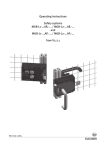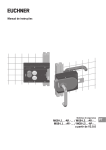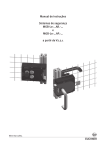Download Operating Instructions Safety Systems with Locking ESL-IH-AR
Transcript
Operating Instructions Safety Systems with Locking ESL-IH-AR More than safety. Operating Instructions ESL Contents Correct use 3 Exclusion of liability and warranty 4 General safety instructions 5 Function5 System overview 6 Modules6 Dimension drawing 6 Changing the connection 7 Mounting8 Electrical connection Safety in case of faults Fuse protection for power supply Requirements for connection cables Maximum cable lengths Connector assignment Connection of a single ESL Connection of several ESL devices in an AR switch chain 9 11 11 11 12 13 14 15 Setup16 LED indicators 16 Teach-in function for handle module (only ESL unicode) 16 Mechanical function test 17 Electrical function test 17 System status table 18 Technical data Technical data for safety system ESL 19 19 Ordering information and accessories 21 Inspection and service 22 Service22 Declaration of conformity 23 2 Operating Instructions ESL Correct use The safety system ESL is an interlocking device without guard locking. In combination with a safety guard, this safety component prevents dangerous machine movements from being performed for as long as the safety guard is opened. A stop command is triggered if the safety guard is opened during the dangerous machine function. Before safety switches are used, a risk assessment must be performed on the machine, e.g. in accordance with: ÌÌEN ISO 13849-1, Safety of machinery. Safety related parts of control systems. General principles for design ÌÌEN ISO 12100, Safety of machinery - General principles for design - Risk assessment and risk reduction ÌÌIEC 62061, Safety of machinery. Functional safety of safety-related electrical, electronic and programmable electronic control systems. Correct use includes compliance with the relevant requirements for installation and operation, for example ÌÌEN ISO 13849-1, Safety of machinery. Safety related parts of control systems. General principles for design ÌÌEN 1088, Safety of machinery. Interlocking devices associated with guards. Principles for design and selection ÌÌEN 60204-1, Safety of machinery. Electrical equipment of machines. General requirements ÌÌEN 60947-5-3, Specification for low-voltage switchgear and controlgear. Con- trol circuit devices and switching elements. Requirements for proximity devices with defined behavior under fault conditions The safety system ESL can only be combined with the intended modules in the ESL system family. On the modification of system components, EUCHNER provides no warranty for function. Several devices are only allowed to be connected in series using devices intended for series connection with the ESL. Check the operating instructions for the related device. A combination with other ESL devices or devices from other manufacturers is not allowed. A maximum of 20 devices are allowed to be operated in a switch chain. Important! ÌÌThe user is responsible for the integration of the device into a safe overall system. For this purpose, the overall system must be validated, e.g. in accordance with EN ISO 13849-2. ÌÌCorrect use requires observing the permissible operating parameters (see Technical data). ÌÌIf a product data sheet is included with the product, the information on the data sheet applies in case of discrepancies with the operating instructions. ÌÌIn the estimation of the PL for the overall system, a maximum value of 100 years can be assumed for the MTTFd according to the limit value in EN ISO 13849-1:2008, section 4.5.2. This corresponds to a minimum value for the PFHd of 2.47x10-8/h. ÌÌWhen up to 11 devices are connected in series, these limit values can be assumed for the entire switch chain as a subsystem. As a subsystem, this switch chain achieves PL e. 3 Operating Instructions ESL Important! ÌÌIn the case of series connection of more than 11 devices, the PFHd can be calculated according to one of the stated methods in EN ISO 13849-1:2008, Section 4.5.1. ÌÌIf the simplified method according to section 6.3 of EN ISO 13849:2008-12 is used for validation, the Performance Level (PL) might be reduced when more than 11 devices are connected in series. Exclusion of liability and warranty In case of failure to comply with the conditions for correct use stated above, or if the safety instructions are not followed, or if any servicing is not performed as required, liability will be excluded and the warranty void. 4 Operating Instructions ESL General safety instructions Safety switches fulfill personal protection functions. Incorrect installation or tampering can lead to fatal injuries to personnel. Check the safe function of the safety guard particularly ÌÌafter any setup work ÌÌeach time after the replacement of an ESL module ÌÌafter an extended period without use ÌÌafter every fault Independent of these checks, the safe function of the safety guard should be checked at suitable intervals as part of the maintenance schedule. Warning! Danger of fatal injury in the event of incorrect connection or incorrect use. ÌÌSafety switches must not be bypassed (bridging of contacts), turned away, removed or otherwise rendered ineffective. On this topic pay attention in particular to the measures for reducing the possibility of bypassing from EN 1088:1995+A2:2008, section 5.7. The switching operation may be triggered only by the handle module ESL‑H... designated for this purpose. The device is only allowed to be installed and placed in operation by authorized personnel ÌÌwho are familiar with the correct handling of safety components ÌÌwho are familiar with the applicable EMC regulations ÌÌwho are familiar with the applicable regulations on health and safety and accident prevention ÌÌwho have read and understood the operating instructions. Important! Prior to use, read the operating instructions and keep these in a safe place. Ensure the operating instructions are always available during mounting, setup and servicing work. EUCHNER cannot provide any warranty in relation to the readability of the CD for the storage period required. For this reason you should archive a printed copy of the operating instructions. If you should lose the operating instructions, you can download this document from www.EUCHNER.de. Function Together with a handle module, the interlocking module makes it possible to interlock movable safety guards. The combination also serves as a mechanical door stop at the same time. The interlocking module detects the position of the closure and thereby the position of the safety guard. 5 Operating Instructions ESL System overview Modules Interlocking module Handle module Closure LED indicator Lock Dimension drawing Possible profiles 30, 40, 45, 50 71,5 46 Red LED 107 109 Maximum vertical offset between interlocking module and handle module ± 1 mm Green LED 12 Interlocking module M12x1 Handle module X1 9 Alignment corresponds to as-delivered state Z 5 Plug connector X1 is adjustable by 8 x 45° 8 68 68 View Z 36 6,6 Assembly with 4 x M6 screw (non-removable screw) + 4 x washer 40 . Interlocking module mounted flush on profile 6 3 7 1 ≥5 4 6 38 58 Gap dimension 0 - 3 mm 2 45° Coding lug Operating Instructions ESL Changing the connection The plug connector position can be adapted to suit the installation. This change must be performed before assembly. 1. Press the plug connector with the plastic inserts out of the profile slot. ¨¨ To adjust only the cable exit for angled plug connectors, align the plug and the inserts accordingly and press the plug back into the profile slot. 2. Remove the connection cap on the opposite side. 3. For angled plug connectors, align the plug and the inserts accordingly. 4. Press the plug into the profile slot on the opposite side. 5. Seal the other opening with the connection cap. 7 Operating Instructions ESL Mounting Caution! ÌÌThe device is not suitable for use on sliding doors. ÌÌWhen mounting, take care not to trap the cables between the device and the profile. ÌÌPermanently connect the actuator and handle module to the safety guard so that it cannot be detached, e.g. using non-removable screws. Important! ÌÌWhen mounting different transponder-coded safety switches, observe the stipulated minimum distance to avoid mutual interference. 60 With two-wing hinged doors, one of the two door wings additionally must be latched mechanically. 1. Fasten the ESL using 4 M6 screws and washers. ¨¨ Please note that the gap dimension between handle module and interlocking module is 0 - 3 mm; the max. vertical offset is ± 1 mm. 2. Tighten the screws to a torque of max. 10 Nm. 3. Fit the enclosed cover caps to protect against tampering. 8 Operating Instructions ESL Electrical connection The following connection options are available: ÌÌSeparate operation ÌÌSeries connection with Y-distributors from EUCHNER ÌÌSeries connection, e.g. with wiring in the control cabinet. Warning! In case of an error, loss of the safety function through incorrect connection. ÌÌTo ensure safety, both safety outputs (FO1A and FO1B) must always be evaluated. ÌÌThe monitoring output OD must not be used as a safety output. ÌÌLay the connection cables with protection to prevent the risk of short circuits. Caution! Risk of damage to equipment or malfunctions as a result of incorrect connection. ÌÌDo not use a control system with pulsing or switch off the pulsing function in your control system. The device generates its own clock signal on the output lines FO1A/FO1B. A downstream control system must tolerate these test pulses, which may have a length of up to 1 ms. The pulses are also present when the safety outputs are switched off. Depending on the inertia of the connected device (control system, relay, etc.), this can lead to short switching processes. ÌÌThe inputs on an evaluation unit connected must be positive-switching, as the two outputs on the safety switch deliver a level of +24 V in the switched-on state. ÌÌAll the electrical connections must either be isolated from the mains supply by a safety transformer according to IEC EN 61558-2-6 with limited output voltage in the event of a fault, or by other equivalent isolation measures. ÌÌFor use and operation as per the requirements*, a power supply with the feature "for use in class 2 circuits" must be used. The same requirement applies to the safety outputs. Alternative solutions must comply with the following requirements: a)Electrically isolated power supply unit with a max. open-circuit voltage of 30 V/DC and a limited current of max. 8 A. b) Electrically isolated power supply unit in combination with fuse as per UL248. This fuse should be designed for max. 3.3 A and should be integrated into the 30 V DC voltage section. ÌÌFor use and applications as per the requirements of *, a connection cable listed under the UL category code CYJV2 must be used. ÌÌAll electrical outputs must have an adequate protective circuit for inductive loads. The outputs must be protected with a free-wheeling diode for this purpose. ÌÌPower devices, which are a powerful source of interference, must be installed in a separate location away from the input and output circuits for signal processing. The cable routing for safety circuits should be as far away as possible from the cables of the power circuits. ÌÌIn order to avoid EMC interference, the physical environmental and operating conditions at the installation site of the device must comply with the requirements according to the standard EN 60204-1:2006, section 4.4.2 (EMC). * Note on the scope of the UL approval: Only for applications as per NFPA 79 (Industrial Machinery) The devices are tested according to the requirements of UL508 (protection against electric shock and fire). 9 Operating Instructions ESL Important! If the device does not appear to function when operating voltage is applied (e.g. green STATE LED does not flash), the safety switch must be returned unopened to the manufacturer. 10 Operating Instructions ESL Safety in case of faults ÌÌThe operating voltage UB is reverse polarity protected. ÌÌThe contacts FI1A/FI1B and FO1A/FO1B are short circuit-proof ÌÌA short circuit between FI1A and FI1B or FO1A and FO1B is detected by the switch. ÌÌA short circuit in the cable can be excluded by laying the cable with protection. Fuse protection for power supply The power supply must be provided with fuse protection depending on the number of devices and current required for the outputs. The following rules apply: Max. current consumption of an individual device Imax Imax = IUB + IOD + IFO1A+FO1B IUB = Switch operating current (max. 40 mA) IOD = Monitoring output load current (max. 50 mA) IFO1A+FO1B = Load current of safety outputs FO1A + FO1B (2 x max. 100 mA) Max. current consumption of a switch chain Σ Imax Σ Imax= IFO1A+FO1B + n x (IUB + IOD) n = Number of connected devices Requirements for connection cables Caution! Risk of damage to equipment or malfunctions as a result of incorrect connection cables. ÌÌUse connection components and connection cables from EUCHNER ÌÌOn the usage of other connection components, the requirements in the following table apply. EUCHNER provides no warranty for safe function in case of failure to comply with these requirements. Observe the following requirements with respect to the connection cables: Parameter Conductor cross-section min. Value Unit 0.14 … 0.34 mm² R max. 150 W/km C max. 120 nF/km 0.65 mH/km L max. Recommended cable type LIYY 8x or 5x 0.34 mm² 11 Operating Instructions ESL Maximum cable lengths Switch chains are permitted up to a maximum overall cable length of 200 m taking into account the voltage drop as a result of the cable resistance (see table below with example data and case example). lmax =200 m l2 l1 ln un = 24 V -20% umin = 24 V -10% SPS PLC iout 5 x 0,34 mm2 ESL-AR # n ESL-AR # n-1 ESL-AR # 1 n IOD (mA) l1 (m) Max. number of devices Possible output current per channel FO1A/FO1B Max. cable length from the last device to the control system 10 150 25 100 50 80 5 6 10 100 50 10 120 25 90 50 70 100 50 10 70 25 60 50 50 100 40 Determining cable lengths using the example table Example: 6 devices are to be used in series. Cabling with a length of 40 m is routed from a safety relay in the control cabinet to the last device (#6). Cables with a length of 20 m each are connected between the individual ESL devices. lmax = 140 m l2 = 5 x 20 m l1 = 40 m ln = 20 m un = min. 19,2 V Sicherheitsrelais iout = min. 75 mA Safety Relay ESL-AR # 6 ESL-AR # 5 ESL-AR # 4 Figure 1: Circuit example with six ESL-AR 12 ESL-AR # 3 ESL-AR # 2 ESL-AR # 1 Operating Instructions ESL A safety relay is connected downstream which consumes 75 mA at each of the two safety inputs. This operates over the whole temperature range with a voltage of 19.2 V (corresponds to 24 V -20%). All the relevant values can now be determined using the example table: 1. Select the corresponding section in the column n (max. number of devices). Here: 6 switches. 2. In column IOD (possible output current per channel FO1A/FO1B), find a current greater than or equal to 75 mA. Here: 100 mA. ¨¨ The maximum cable length from the control system to the start of the switch chain is listed in column l1. Here: a length of 50 m is permitted. Result: The desired cable length l1 of 40 m is below the permitted value from the table. The overall length of the switch chain lmax of 140 m is less than the maximum value of 200 m. ¨¨ The planned application is therefore functional in this form. Connector assignment RST UB 0V FI1A FI1B FO1A FO1B OD 8 2 7 6 7 8 6 1 5 4 1 3 4 5 Coding lug 2 3 View on the connection side of the safety switch Figure 2: Connector assignment Pin Wire color as per DIN 47100 Designation Description 1 FI1B Enable input for channel 2 white 2 UB Power supply, DC 24 V brown 3 FO1A Safety output, channel 1 green 4 FO1B Safety output, channel 2 yellow gray 5 OD Monitoring output 6 FI1A Enable input for channel 1 pink 7 0V Ground, DC 0 V blue 8 RST Reset input for hardware reset red 13 Operating Instructions ESL Connection of a single ESL If a single ESL is used, connect the device as shown in Figure 3. The OD output can also be connected here to a control system as a monitoring output. The device can be reset via the RST input. To do this, a voltage of 24 V is applied to the RST input for at least 3 seconds. The supply voltage to the switch is interrupted during this time. The RST input must be connected to 0 V if it is not used. RST A1 -K1 13 14 A2 8 0V 7 6 FI1A OD 5 4 FO1B 3 FO1A UB 2 1 FI1B DC 24 V -K2 M12 plug-connector (8-pin) ESL-AR #1 A1 13 A2 14 -M1 M GND Figure 3: Connection example for a single ESL-AR Warning! In case of an error, loss of the safety function through incorrect connection. ÌÌTo ensure safety, both safety outputs (FO1A and FO1B) must always be evaluated. Single-channel use of the safety outputs leads to a reduction of the category in accordance with EN ISO 13849-1. 0V RST 7 8 OD 6 FI1A 5 4 FO1B 3 FO1A UB 2 1 FI1B DC 24 V A1 -K1 13 A2 M12 plug-connector (8-pin) ESL-AR #1 14 -K2 A1 13 A2 14 -M1 GND Figure 4: Example of incorrect connection. 14 M -M2 M Operating Instructions ESL Connection of several ESL devices in an AR switch chain Important! ÌÌA switch chain may contain a maximum of 20 safety switches. ÌÌIn the estimation of the PL for the overall system, a maximum value of 100 years can be assumed for the MTTFd according to the limit value in EN ISO 13849-1:2008, section 4.5.2. This corresponds to a minimum value for the PFHd of 2.47x10-8/h. The devices are connected in series using plug connectors and Y-distributors. If a safety door is opened or if a fault occurs on one of the switches, the system shuts down the machine. A higher level control system can, however, not detect which safety door is open or on which switch a fault has occurred. The switches can be reset via the RST input. To do this, a voltage of 24 V is applied to the RST input for at least 3 seconds. The supply voltage to the switches is interrupted during this time. The RST input must be connected to 0 V if it is not used. DC 24 V Y-Verteiler/Y-distributor Stift/ connector (male) Buchse/ connector (female) Y-Verteiler/Y-distributor Stift/ connector (male) Buchse/ connector (female) Y-Verteiler/Y-distributor Stift/ connector (male) Buchse/ connector (female) Kurzschlussstecker/ Short-circuit plug 5 5 M12 plug-connector (8-pin) ESL-AR #n 1 2 M12 plug-connector (8-pin) ESL-AR #n-1 2 8 3 4 5 6 7 8 5 7 UB 6 1 FI1B 5 0V 4 RST 3 8 2 7 1 UB 8 2 7 1 FI1B 6 0V 5 RST 4 8 3 7 2 UB 1 0V 5 RST 5 8 5 7 5 OD 4 5 6 FI1A 3 4 4 FO1B 3 4 3 FO1A 3 4 OD 3 4 6 FI1A 3 4 5 3 4 4 FO1B 3 3 FO1A 2 OD 1 2 6 FI1A 1 2 5 1 2 4 FO1B 1 2 3 FO1A 1 2 2 1 2 1 FI1B 1 Stift/ connector (male) M12 plug-connector (8-pin) ESL-AR #1 Connected load GND Figure 5: Connection example for series connection of several ESL-AR devices 15 Operating Instructions ESL Setup LED indicators LED STATE DIA Color green red State Significance illuminated Normal operation flashing Teach-in operation or Power Up (for further signal function see status table) illuminated - Internal electronics fault - Fault at the inputs/outputs Teach-in function for handle module (only ESL unicode) The handle module must be assigned to the interlocking module using a teach-in function before the system comprising interlocking module and handle module forms a functional unit. During a teach-in operation, the safety outputs are in high-resistance state, i.e. the system is in the safe state. When a handle module for which teach-in operation is possible is in the operating distance, monitoring output OD indicates this with a HIGH signal. Important! ÌÌThe interlocking module disables the code for the previous handle module if teach-in is carried out for a new handle module. Teach-in is not possible again immediately for this actuator if a new teach-in operation is carried out. The disabled code is deleted again in the interlocking module only after a third code has been taught. ÌÌThe interlocking module can only be operated with the last handle module taught. ÌÌThe interlocking module enters normal operation when it detects the taught handle module after power up. ÌÌIf the interlocking module detects a disabled handle module during teach-in operation, it enters a fault state at the end of the teach-in operation. ÌÌIf the closure is within the operating distance for less than 30 seconds, the handle module is not taught in and the interlocking module enters the fault state. Teaching in handle module 1. Fit handle module. 2. Close safety guard. Check for correct alignment and distance and readjust if necessary. 3. Apply operating voltage to the interlocking module. ¨¨ The green LED flashes quickly (approx. 5 Hz) A self-test is performed during this time (approx. 8 s). Teach-in operation starts, green LED flashes slowly (approx. 1 Hz). The teach-in operation is ended after approx. 30 seconds and is positively acknowledged with an alternating red/green flashing sequence. 4. To activate the handle module's code from the teach-in operation in the interlocking module, the operating voltage must then be switched off at the interlocking module for min. 3 seconds. As an alternative, 24V can be applied to the input RST for min. 3 seconds. 16 Operating Instructions ESL Mechanical function test It must be possible to insert the closure easily into the interlocking module. Close the safety guard several times to check the function. Electrical function test After installation and any fault, the safety function must be fully checked. Proceed as follows: Warning! Danger of fatal injury as a result of faults in installation and functional check. ÌÌBefore carrying out the functional check, make sure that there are no persons in the danger area. ÌÌObserve the valid accident prevention regulations. 1. Switch on operating voltage. ÌÌThe interlocking module carries out a self-test. The green STATE LED flashes for 8 s with 5 Hz. The STATE LED then flashes at regular intervals. 2. Close all safety guards. ÌÌThe machine must not start automatically. ÌÌThe green STATE LED illuminates continuously. 3. Enable operation in the control system. 4. Open the safety guard. ÌÌThe machine must switch off and it must not be possible to start it as long as the safety guard is open. ÌÌThe green STATE LED flashes at regular intervals. Repeat steps 2-4 for each safety guard. 17 Operating Instructions ESL System status table Normal operation X off closed on open off 1x Door open open off 2x Door open, no handle module taught (see setup for teach-in operation) closed off approx. 30 s X off ∞ Positive acknowledgment after completion of teach-in operation X off 1x Error during teach-in X off 2x closed off 3x X off 4x X off 5x X off STATE (green) Safety outputs FO1A and FO1B Self-test Handle module/door position State DIA (red) Operating mode LED indicator, output 5 Hz (8 s) Self-test after power up Door closed Setup Teach-in operation inverted Input error (e.g. missing test pulses, illogical switch state from previous switch) Faulty handle module (e.g. error in code or code cannot be read) Fault display inverted Output error (e.g. short circuits, loss of switching ability) Blocked handle module Internal fault (e.g. component faulty, data error) LED not illuminated LED illuminated 5 Hz (8 s) LED flashes for 8 seconds at 5 Hz Key to symbols X 3x LED flashes three times ∞ LED flashes continuously Any state After the cause has been remedied, faults can generally be reset by opening and closing the door. If the fault is still displayed afterward, use the reset function or briefly interrupt the power supply. Please contact the manufacturer if the fault could not be reset after restarting. Important! If you do not find the displayed device status in the System status table, this indicates an internal device fault. In this case, you should contact the manufacturer. 18 Operating Instructions ESL Technical data Note: If a product data sheet is included with the product, the information on the data sheet applies in case of discrepancies with the operating instructions. Technical data for safety system ESL Parameter Value min. Housing material typ. Unit max. Diecast aluminum, black powder coated Dimensions See dimension drawing Mass 0.4 Ambient temperature at UB = DC 24 V - 20 Degree of protection - kg + 55 °C IP 67 Safety class III Degree of contamination 3 Installation position Any Connection M12 plug connector, 8-pin Operating voltage UB (PELV, reverse polarity protected, regulated, residual ripple < 5%) For the approval according to the following applies 24 ± 15% V DC Operation only with UL class 2 power supply according to UL 1310, or equivalent measures Current consumption 40 mA 3 A DC 24 V, class 2 Switching load according to External fuse (operating voltage) 0.25 Safety outputs (FO1A/FO1B) - Semiconductor outputs, p-switching, short circuit-proof - Output voltage 1) HIGH U (FO1A) HIGH U (FO1B) LOW U (FO1A/FO1B) 0 Switching current per safety output 1 Utilization category according to EN IEC 60947‑5‑2 UB-1.5 - UB - 150 V DC 1 mA DC-13 24 V 100 mA Caution: outputs must be protected with a free-wheeling diode in case of inductive loads. Monitoring output OD p-switching, short circuit-proof 0.8 x UB - UB V DC - Max. load - - 50 mA Safe switch-off distance sar in door opening direction 2) - - 0 mm Rated insulation voltage Ui - - 75 V Rated impulse withstand voltage Uimp - - 0.8 kV - Output voltage 1) Rated short-circuit current 100 Resilience to vibration A In acc. with EN IEC 60947-5-2 Switching frequency - Repeat accuracy R - 0.5 ≤ 10 EMC protection requirements Hz % In acc. with EN IEC 60947-5-3 Switching delay from state change 3) - - 400 ms Difference time between the two safety outputs - 10 - ms Reliability values acc. to EN ISO 13849‑1 Category 4 Performance Level PL e 1.9 x 10 -9 / h PFHd Mission time 1) 2) 3) 20 years Values at a switching current of 50 mA without taking into account the cable length. An sar of 0 mm in door opening direction can be assumed for the calculation of characteristic safety values. Corresponds to the risk time according to EN 60947‑5‑3. This is the maximum switch-off delay for the safety outputs after pulling on the handle module. 19 Operating Instructions ESL Typical system times Ready delay: After switching on, the unit carries out a self-test for 8 s. The system is ready for operation only after this time. Risk time according to EN 60947-5-3: If a handle module moves outside the operating distance, the safety outputs FO1A and FO1B on the corresponding interlocking module are deactivated after a maximum of 260 ms. If more than one device is used, the value increases correspondingly (see System times for switch chains). Difference time: The safety outputs FO1A and FO1B switch with a slight delay in relation to each other. They have the same signal state at the latest after a difference time of 10 ms. System times for a single device = Safety outputs active toff = Switch-off time t0 = Fault time/event Pulling on handle module Missing signal FI1A/FI1B Non-identical input state at FI1A/FI1B Short circuit or cross circuit at FO1A/FO1B or internal fault t (ms) toff = t0 + 300 ms t0 toff = t0 + 260 ms toff = t0 + 150 ms Figure 6: System times for single device System times for switch chains Important! The system times shown are maximum values for a circuit arrangement with 20 safety switches connected in series. Shorter times can also be achieved in circuits with fewer switches. = Safety outputs active toff = Switch-off time t0 = Fault time/event Pulling on handle module Missing signal FI1A/FI1B Non-identical input state at FI1A/FI1B Short circuit or cross circuit at FO1A/FO1B or internal fault t (ms) toff = t0 + 400 ms t0 toff = t0 + 360 ms toff = t0 + 250 ms Figure 7: System times for switch chains 20 Operating Instructions ESL Ordering information and accessories Y-distributor 111696 2 3 4 1 Short circuit connector 097645 4-pin, plug 5 8 6 7 Y-distributor 097627 4 5 8 M12x1 15,1 6 M12x1 15 15 41 7 ( 45 °) 45 2 3 1 200 M 12x1 097627 A B 42,5 33 44 M 12x1 Ø 14,6 M 12x1 Plug M12x1 3 3 Ø 14,5 5 2 5 4 2 4 1 1 15 Socket Plug 20,5 35,1 2 3 2 3 5 5 4 4 1 Socket 1 Pin Function Pin Function Pin Function Pin Function 1 UB 1 UB 1 UB 1 UB 2 OA (FO1A) 2 IA (FI1A) 2 OA (FO1A) 2 IA (FI1A) 3 0V 3 0V 3 0V 3 0V 4 OB (FO1B) 4 IB (FI1B) 4 OB (FO1B) 4 IB (FI1B) 5 RST 5 RST 5 RST 5 RST Designation Short-circuit plug Version Order no. M12, 4-pin, plug 097645 Y-distributor M12 with connection cable M12, 1x8-pin, 2x5-pin 111696 Y-distributor M12, 1x8-pin, 2x5-pin 097627 Connection cable PVC 8-core, flying lead M12, 8-core, 5 m 100177 M12, 8-core, 10 m 100178 M12, 8-core, 20 m 100179 Tip! Additional accessories, particularly for series connection, can be found at www. euchner.de. 21 Operating Instructions ESL Inspection and service Warning! Loss of the safety function because of damage to the system. In case of damage, the affected module must be replaced. Replacement of individual parts of a module (e.g. parts of the interlocking module) is not permitted. Regular inspection of the following is necessary to ensure trouble-free long-term operation: ÌÌCheck the switching function (see section Function test) ÌÌCheck the secure fastening of the devices and the connections ÌÌCheck for soiling No servicing is required; repairs to the device are only allowed to be made by the manufacturer. Note: The year of manufacture can be seen in the lower right corner of the rating plate. Service If service support is required, please contact: EUCHNER GmbH + Co. KG Kohlhammerstraße 16 D-70771 Leinfelden-Echterdingen Service telephone: +49 711 7597-500 E-mail: [email protected] Internet: www.euchner.de 22 Operating Instructions ESL Declaration of conformity 23 Euchner GmbH + Co. KG Kohlhammerstraße 16 D-70771 Leinfelden-Echterdingen [email protected] www.euchner.de Edition: 119138-04-04/14 Title: Operating Instructions Safety Systems ESL-IH-AR (translation of the original operating instructions) Copyright: © EUCHNER GmbH + Co. KG, 04/2014 Subject to technical modifications; no responsibility is accepted for the accuracy of this information. More than safety.











































